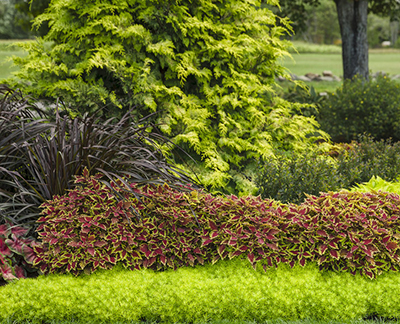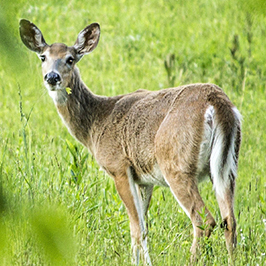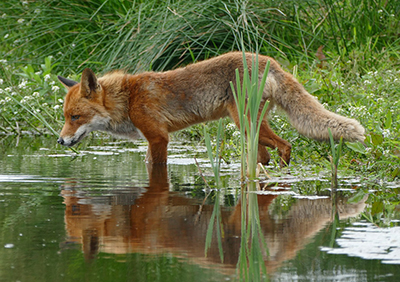Gardening for Wildlife: 3 Essentials for a Welcoming Habitat
Gardens exist not just for the benefit of the people who enjoy them but for all of the wildlife in the ecosystem. We plant flowers and plants to attract bees, songbirds, butterflies and hummingbirds, but bats, squirrels and frogs also benefit from them. Unfortunately, along with these kinds of wildlife also come the raccoons, opossums, skunks, rabbits and deer.
3 ESSENTIALS FOR A WILDLIFE-FRIENDLY OUTDOOR SPACE
In order to attract wildlife to the garden, you'll need to meet their three basic needs: cover, water and food.
 1. CoverCover provides refuge from predators and the weather as well as a safe place to raise young. Different animals and insects need different kinds of cover. A simple pile of leaves or sticks tucked into a corner, hollow logs and densely canopied trees and shrubs can all provide cover. You could also leave a patch of long grass or leave perennials uncut over the winter for shelter. Tip: Offer additional shelter by installing nesting boxes for birds, bats, or small mammals. These provide safe spaces for wildlife to breed and raise young, enhancing your wildlife-friendly garden. |
|
|
PLANT WITH A PURPOSE
Plants play a huge roll in providing pollen, nectar and seeds for bees, butterflies, hummingbirds, songbirds and insects.
Check out these resources for more information:
 HummingbirdsAttracting hummingbirds |  BirdsShrubs to Attract Birds Bird-Friendly Garden |  ButterfliesAttracting butterfliesArticle and plant list |
 Bees & PollinatorsProtecting Our Pollinators through Responsible Growing Practices |  Deer Control |  Attracting WildlifeWinter Plants for Wildlife |
As much as possible, incorporate native plants into your garden to create a resilient and wildlife-friendly environment. Native species are adapted to local conditions, making them easier to grow and more beneficial to local wildlife. They provide essential food and shelter for pollinators, birds, and other creatures, helping to protect wildlife and enhance biodiversity.
Tip: Create a diverse and thriving habitat garden by planting in layers. Use tall trees as the top canopy, shrubs in the middle, and ground cover or perennials at the base. This layering mimics natural ecosystems, offering shelter and food for various species.
It's important to remember that you can help to support the wildlife around you with any size garden. You don't need several acres of land to support most of the kinds of animals and insects you'd like to see in your garden. A simple potted plant on a balcony can feed butterflies, bees and hummingbirds. In the garden, try to create a mix of open grassy areas, gardens and taller trees to provide plenty of shelter and feeding opportunities for wildlife.
Tip: Use our plant finder to discover plants for your wildlife garden. Simply select you hardiness zone, pick which type of wildlife you want to attract and check other characteristics important to you. Click submit, and voila!
MORE WAYS TO SUPPORT WILDLIFE IN YOUR GARDEN
- Create a Wildflower Meadow: A wildflower meadow adds beauty and supports pollinators like bees and butterflies. Use native wildflowers that offer nectar and seeds, contributing to a habitat garden that encourages biodiversity.
- Design a Certified Wildlife Habitat: Consider turning your garden into a Certified Wildlife Habitat through the National Wildlife Federation. This designation helps ensure your space supports wildlife through food, water, shelter, and breeding grounds.
- Control Pests with Wildlife in Mind: Practice natural pest control by attracting beneficial insects and birds to your garden. Avoid harmful pesticides and let predators like ladybugs and bats naturally keep pests in check.
- Join the Homegrown National Park Movement: Contribute to Homegrown National Park, a nationwide effort to restore natural habitats one garden at a time. By planting native species, you help create vital wildlife corridors and protect biodiversity, even in urban or suburban areas. Every garden can make a difference!
- Grow a Plant Community of Habitat Plants: Strategically combine annuals, perennials, and shrubs to support diverse wildlife. Plants with throated flowers attract insects with long tongues. Low foliage provides butterflies with shelter as birds move around. Shrubs with strong branches make great nesting sites and offer protection during colder months.
More articles about wildlife in your garden.
Buy Proven Winners plants:



 2. Water
2. Water 3. Food
3. Food
